
Looking out over the hop rows, it’s hard to believe how much has changed in just 12 months. A year ago, Rogue Farms was short 20 inches of rain. The alluvial soil in the hop rows was dry as a bone and hard as a rock. The Rogue team wondered if they could even grow hops under such conditions. The National Weather Service declared a severe drought at the farm — not the kind of words you normally associate with rainy Oregon.
But Mother Nature, knowing just what was needed, turned on the spigot in February and March in the form of rain, snow and floods.
“As TV news helicopters flew overhead to record the “damage,” we smiled, knowing that a good soak would do our hops a world of good. Just to make sure everything was okay, Mother Nature sent more floods this December. So we begin a new year in good shape, with moist soil and the promise of another season of growing beers, spirits, ciders and sodas,” Rogue reports.
Guardians of the dirt
One of the most valuable resources at Rogue Farms is the dirt. It took millions of years to create the alluvial soils at the farm. It’s not something you can buy off store shelves. Dirt matters because that’s where beer and spirits first grow. Planting hops a few miles away in different soil, would mean a different taste and produce a lower quality crop.
A major winter storm dumped several inches of rain on Rogue Farms just before Christmas Day, 2014. Protecting the soil, the heart of Rogue Farms terroir, becomes especially crucial during winter. This is the rainy season, when heavy downpours and rushing floodwaters can wash away topsoil. To keep the soil from eroding during winter, every fall Rogue plants a crop of barley in between the hop rows. They won’t harvest this barley, nor malt, mash, brew or distill it. It will never become an ingredient in its proprietary palate of flavors. This barley is a winter cover crop. Its only job is to safeguard the hop yard from erosion.
How does it work?
The barley roots form a tight web that keeps the top layers of the soil in place during heavy rains. And if it floods, the shoots lie down like a woven blanket for more protection. These tiny guardians of the dirt are very good at their job, helping to preserve the soil and giving the hops the best start possible in spring. After protecting the hop yard during winter, the winter cover crop of barley will die off the following spring.
Winter in the Rogue Farms hop yard
What’s difference between a hop yard and a wild plant known as humulus lupulus? It’s the trellis. It’s wasn’t until our brewing ancestors learned how to grow hops up a trellis that an aromatic weed became a crop. A sturdy trellis is as important to growing hops as is having the right soil and climate. By late summer, the poles and wires will strain under the weight of the bines and cones. Should a pole break, or a wire snap, a whole section of the hopyard could come crashing to the ground.
Replacing poles and wires before they become a problem is key to running a hop yard. It takes a lot of hard work to keep a trellis in good shape, and the best time for maintenance is winter. With the rhizomes safely tucked away in the soil, poles and wires are worked on without damaging the hops. It’s also the coldest and rainiest time of year. As farmers, the Rogue team doesn’t get to choose when to do its chores. Here is the Rogue Farms guide to replacing a hop yard pole, in three not-so-easy steps:
Step 1: Dig a hole
Start in the dirt. New poles will need new holes. If you’re replacing a pole, clean out the old hole.
Step 2: Put pole in the hole
Just one hop yard pole weighs a few 100 pounds, but this guy insisted on doing all of the work himself.
Step 3: Fill in with dirt
When the hole is filled and the dirt packed down, tie down the poles with cables for added stability. In spring, Rogue strings the trellises and then stakes and trains the hops.
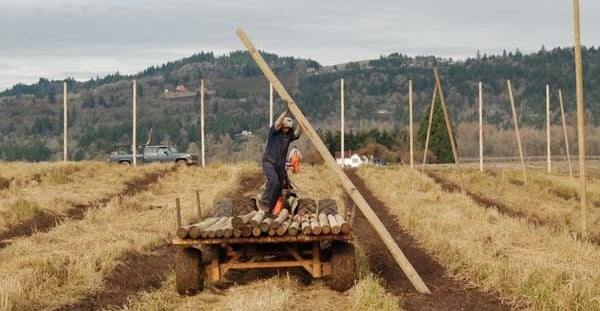
Field of dreams
In the final days of fall, Rogue planted next year’s crop of Dream Rye in a 20-acre field up by the hazelnuts. A fall seeding gives provides a head start when the growing season begins in the spring. This year, Rogue is crafting a new spirit with its Dream Rye: Rogue Spirits Oregon Rye Whiskey. No slugs have dared to attack this patch of rye, and by planting on higher ground they should avoid any problems with floods. But Mother Nature is full of surprises, and who knows what she’ll send over this winter. The first shoots of Dream Rye emerged in December.
The honeybees are California dreaming
The Rogue team loaded the colonies for the trip south began early in the morning, hoping to complete the journey by nightfall so that the bees would spend as little time as possible on the road. It was quite a year for the 7.14 million Rogue Farms honeybees. Rogue used the honey they produced in the new line up of Rogue Sodas, in addition to its 19 Original Colonies Mead, Honey Kolsch and Marionberry Braggot. Growing honey is hard work, the bees were sent south for a well deserved winter break.
In January, the honeybees were driven 600 miles south to sunny California where they’ll spend winter pollinating the beautiful white blossoms in the almond orchards. Winter is hard on the colonies, making them more susceptible to deadly Varroa Mites, American Foulbrood and fungal diseases. The bees produce sweet, dark amber Rogue Farms Wildflower Honey. Getting them out the cold and rain is one of the ways to take care of them.
The honeybees will return in the spring, just as the cherry and apple blossoms start to pop. When summer comes, they’ll be busy pollinating the jalapeños and Dream Pumpkins, and searching for nectar in the blackberries, clover and wildflowers. The honey they make for the mead, kolsch, braggot and sodas is the true taste of the terroir of Rogue Farms.
Two pigs in a pen

Two things to know about Rogue’s potbellied pigs, Voo and Doo. First, they don’t like change. Second, they’ll eat just about anything. For example, fresh bedding was put in their pen to help them stay cozy this winter. As bales of straw and cedar chips were spread out, the pigs refused to come inside and instead watched through the door as if the Rogue team was up to something suspicious. Eventually Voo got the courage to come in and, when it was clear that she was going to survive, Doo followed her. Then they tried to eat it. After all, that’s what pigs do. It took them a few minutes to figure out that their new bed was not edible. Then they dove in and began burrowing into the layers of straw and chips. Warm and content, Voo and Doo will be available to greet visitors to the farm this winter.
How DIY is transforming the revolution
Rogue began hand picking its Wigrich corn on a cold and wet November morning. Of all the ingredients in the proprietary palate of flavors, Wigrich Corn deserves a special mention.
“Our first ever crop of corn tested us in ways we never imagined. From picking, to shucking, shelling and malting, the conveniences of modern farming let us down,” Rogue stated. “At every step, we had to get by on our wits and determination. It would have been easier for us to give up on our corn and just buy some. But because of our dedication to DIY, we weren’t about to let a little hard work get in the way of our dream of crafting bourbon from corn we grew and malted ourselves.
“We planted five acres of Wigrich corn in July. It was soon clear that this was going to be an excellent crop. The seeds loved the alluvial soils of the Wigrich Appellation and the stalks grew quickly in the long days of summer sunshine. Almost immediately, we began looking for someone to combine our corn for us in the fall. But time and again, we were told by professional harvesters that our crop was too small to be worth their time and energy.
This is the kind of problem small farmers have dealt with for decades. We were reminded of what happened to our fellow Willamette Valley hop growers in the 1950’s, when mechanized hop picking replaced picking by hand. Small growers couldn’t afford to buy the new machines, so they pulled out their rhizomes and planted something else. Tens of thousands of hop acres disappeared and never came back. We were not about to let that happen to our Wigrich Corn.”
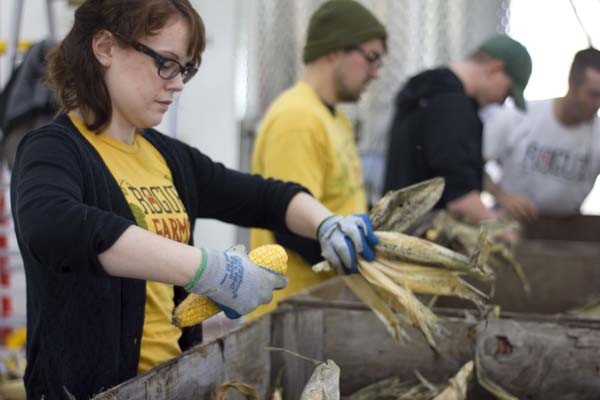
Over two days in November Rogue picked 18,563 ears, all by hand. It was cold, wet and miserable, but it had to be done. When the corn arrived at Farmstead Malt House in Tygh Valley, Rogue was let down again. The fancy equipment bought to shuck and shell the corn wasn’t up to the job. Instead of clean kernels, they got mangled up ears. Even their dog Wasco could’ve done better.
Again, Rogue employees rose to the challenge. A bunch of them loaded into the bus one day and drove to Tygh Valley to hand shuck all 18,563 ears of corn. While corn is a common ingredient in beer, corn malt is not. Most brewers use grits, flakes, flour or torrified corn in their mashes.
It would have been simple for Rogue to do that too, but Rogue is not shy about doing things the hard way. They looked for information on how to floor malt the corn. What kind of steeping rates and water temperatures work best? How long do they let the corn germinate on the floor and how often do they flip it? What are the ideal temperatures for kilning? There was no research, information or instruction manuals to guide them. That’s how rare it is to floor malt and micro-malt your own corn.
Rogue began experimenting with small test batches of corn over the summer. Their maltsters tested various techniques, improving upon what worked and moving past the failures. The DIY Revolution will go forward this winter at the Farmstead Malt House as they create their first batch of Rogue Farms Corn Malt from the Wigrich Corn grown at Rogue Farms in Independence.
“Following your dreams and staying dedicated to doing it yourself isn’t easy,” Rogue concluded. “We won’t be tied to a schedule as we mash, ferment, distill, ocean age and hand bottle our Rogue Spirits Sweet Corn Bourbon. But when you open that bottle for the first time, you’ll be tasting a bourbon that’s unlike anything else.”
This information was all provided from the fine folks at Rogue Ales & Spirits and the Rogue Department of Agriculture.

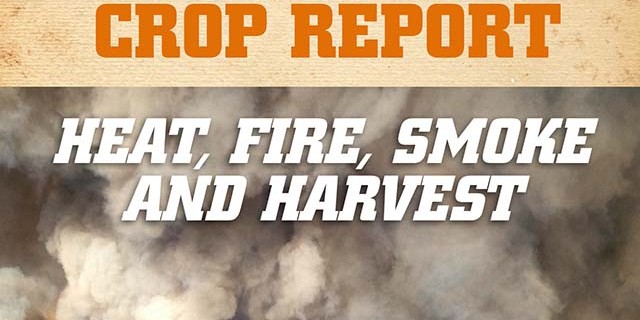
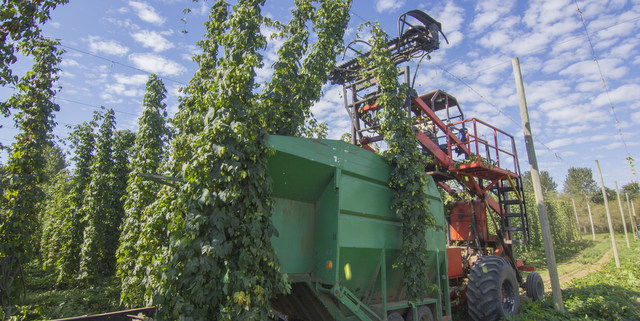
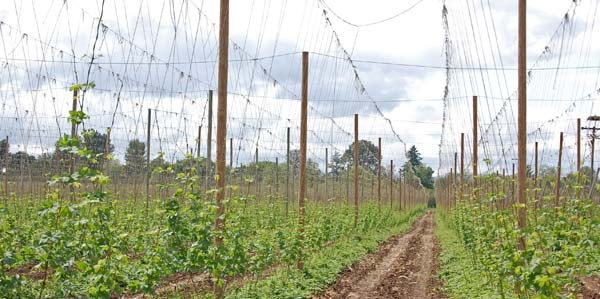
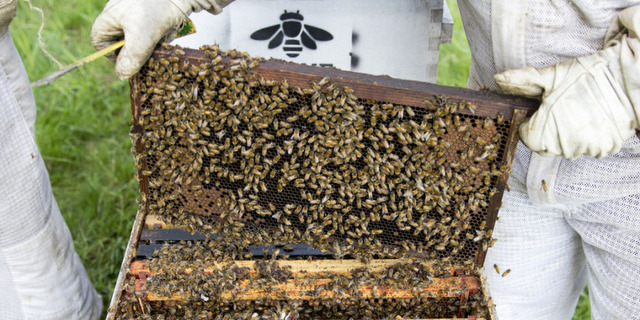
RT @RogueAles: A closer look at the @RogueFarms #cropreport from @CraftBrewingBiz: http://t.co/NsS054kd7f
RT @RogueAles: A closer look at the @RogueFarms #cropreport from @CraftBrewingBiz: http://t.co/NsS054kd7f
Rogue Department of Agriculture Crop Report Winter 2015 http://t.co/9pPMpqTHmL
RT @RogueAles: A closer look at the @RogueFarms #cropreport from @CraftBrewingBiz: http://t.co/NsS054kd7f
RT @RogueAles: A closer look at the @RogueFarms #cropreport from @CraftBrewingBiz: http://t.co/NsS054kd7f
RT @RogueAles: A closer look at the @RogueFarms #cropreport from @CraftBrewingBiz: http://t.co/NsS054kd7f
A closer look at the @RogueFarms #cropreport from @CraftBrewingBiz: http://t.co/NsS054kd7f
Learn about the #GYO Revolution. Read our Winter Crop Report with @craftbrewingbiz http://t.co/Ko7NH3dyDm http://t.co/9SWK6ymVUP